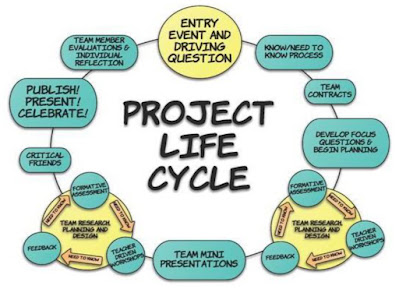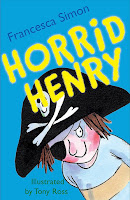UNIT 7 - PROJECT BASED / EXPERIENTIAL LEARNING
1. PROJECT BASED LEARNING (PBL)
Project-based learning is a dynamic classroom approach in which students actively explore real-world problems and challenges and acquire a deeper knowledge.
1.2. Steps in PBL cycle
- Start with the Essential Question
- Design a Plan for the Project
- Create a Schedule
- Monitor the Students and the Progress of the Project
- Assess the Outcome
- Evaluate the Experience
1.3. Implementing PBL: Management
There are many aspects that the teacher should think about before implementing a project based learning dynamic in the classroom. For example:
- How to keep students focused on the driving question and moving forward as they research, plan, and develop?
- What tools will help both teacher and students students stay organised? ➡️ PROJECT WALLS are effective because they include a calendar of deadlines and every new research/product can be added to keep track of the project.
- Student Time Management: How can the teacher help students stick to a deadline? ➡️ Organisation spreadsheets are a useful tool to assign task leaders and deadlines, thus making the students know when to hand their work.
- Team Management
- How can the teacher help students collaborate effectively?
- How can the teacher ensure all students are contributing equally to towards their team's goals? ➡️ Spreadsheets with involvement time of each student are a good way for the teacher to see everyone’s contribution to the project.
- Evaluation and Assessment
- How will the teacher know that students are learning the skills they are supposed to be learning before it is too late?
- How will the teacher check team progress?
- Celebrating and Reflecting
PBL from the Students' Perspective
- A project that is relevant to my own life and personally meaningful. Completing it requires me to do tasks that really matter.
- An exploration into an authentic problem. My goal is to solve the problem and present my solution—or a tangible product—to a knowledgeable and interested audience, oftentimes from beyond my classroom.
- Having a voice in how I investigate the problem, and input on what the final outcome/product should be.
- A learning strategy that encourages me to regularly evaluate my progress based on my individual work or my participation and contribution to a group’s work.
PBL from the Teachers' Perspective
- A meaningful project that fulfils objectives within a core curriculum.
- A strategy that begins with a driving question that engages students and motivates them to learn the material. The driving question might be stimulated by the teacher and/or the students.
- A learning process that encourages students to revise their research when necessary and to reflect on their progress throughout the project.
- An evaluation based on a set rubric that assesses student collaboration, participation, in addition to the content.
2. EXPERIENTIAL LEARNING
2.1. Elements
According to Kolb, knowledge is continuously gained through both personal and environmental experiences. Kolb states that in order to gain genuine knowledge from an experience, the learner must have four abilities:
- The learner must be willing to be actively involved in the experience.
- The learner must be able to reflect on the experience.
- The learner must possess and use analytical skills to conceptualise the experience.
- The learner must possess decision making and problem solving skills in order to use the new ideas gained from the experience.
Jacobson and Ruddy, building on Kolb's four-stage Experiential Learning Model and Pfeiffer and Jones's five stage Experiential Learning Cycle, took these theoretical frameworks FACILITATORS to use in promoting critical reflection and created a simple, practical questioning model for in experiential learning. Their "5 Questions" model is as follows:
- DID YOU NOTICE...?
- WHY DID THAT HAPPEN?
- DOES THAT HAPPEN IN LIFE?
- WHY DOES THAT HAPPEN?
- HOW CAN YOU USE THAT?
HOW DIFFERENT WOULD ARANJUEZ BE WITHOUT THE GARDENS?
1. Start with the Essential Question: How different would Aranjuez be without the gardens?
2. Design a Plan for the Project:
Age: 11 years old. 5th year of Primary.
Level: Advanced A2 or early B1.
CLIL school in Aranjuez: Content + language teacher.
Social Science: History (Patrimony), culture, economic sectors (tourism).
Contents:
Natural and cultural heritage as an asset and resource; its use, care and conservation.
Social and environmental responsibility. Relationship between living beings and ecosystems and between people, societies and the natural environment.
Objectives:
To explain the existing codependence between the social issues of their immediate context.
To find information about the topic using the resources available (books, computers, etc.)
To create products that reflect successful research skills
To reflect on the similarities and differences between their previous ideas and newly found ones (critical thinking)
Language Skills:
Using connectors and words they understand (it’s better to use simple words they can pronounce and understand correctly than long complicated words that are difficult for them just to “seem smart”).
Listening, speaking and conversation
Negotiating in FL
Expressing and defending own ideas
Describing and explaining some ideas about their topic
Actively trying to understand other classmates’ explanations
Reading and writing
Scanning and skimming the text to extract key information
Filtering the information to distinguish between key ideas and details.
Writing in an organized way depending on what they’re working on.
Adequating the register
3. Create a Schedule
FIRST SESSION: INITIATION TO THE QUESTION
1) Brainstorming (class group)
The children give immediate answers to the question, without research, to see the initial level. From there, we specify areas we can investigate about.
- Areas that might come up: environment (ecology: nature, animals, plants), tourism, economy, history, sports, leisure, interculturality.
If some of the topics don’t come up, the teacher can encourage the students through questions.
The whole class then votes to choose which 5 topics they want to research about to see their influence in the town.
Apart from PBL we will use the methodology of jigsaw learning, all whose elements are explained here.
2) After the brainstorming, we create "home groups", and each person of the group chooses a topic to become an expert on (if there are any problems, the teacher will give the topics).
3) When the topics are divided, students do a free writing activity for 5/7 minutes in which they explain previous knowledge, expectations, things they’d like to research…). After this is finished, each student creates a mind map from that text, organising and synthetising the ideas (5 minutes).
SECOND SESSION; EXPERT GROUPS
1) The home groups are dissolved into expert groups: each expert from each home groups gathers with the other students who chose the same topic as them.
2) At first, each expert shares their mind maps with their previous knowledge and expectations on the topic, and they agree on a plan to research.
3) The group researches on the topic, and they write down the key ideas. They will need of cooperative learning skills to divide the work, contribute to the common product and share roles.
THIRD SESSION: GRAFFITI
1) The students go back to their home groups and explain the key ideas of their topic to their peers.
2) The group write down the key ideas of every topic, and they all have to contribute as they have all heard all the information. Among those key ideas, they choose the two they think are most representative of the area.
3) Graffiti: five charts (one per topic) are placed in a circle. The students start in one chart and write their 2 selected key ideas about that topic on it. Then they rotate, and the next group adds theirs (if the previous group wrote their selection first, they look at their paper and choose others). At the end, there are five charts that contain everyone's ideas about every topic they chose to research about, and that will be the base of their reflection about the question.
FOURTH SESSION - DEBATE
1) The home groups are distributed in a circle. The teacher brings the answers they gave in the brainstorm, and they have to compare their answers with the new ones, check whether they were right or wrong, if they had any misconceptions that are now solved, etc.
2) The teacher then brings up the essential question and they have 2 minutes to create an answer and support it, and also discuss their classmates' answers and whether they agree with it or not. The teacher will monitor the turns, and students have to respect the silent period and other’s opinions.
4 + 5. Monitor the Students and the Progress of the Project + Assess the outcome
6. Evaluate the Experience.
The students will carry out a self-evaluation with the same rubric, and they can add comments on whether they liked it or not, the difficulty of the activity and their self-improvement. The teacher will compare their rubrics and her own ones, and get feedback on the experience (and re-orientate it if necessary).



.png)
.png)



Comentarios
Publicar un comentario